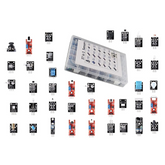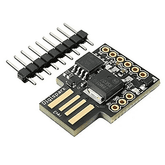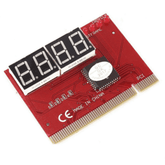Arduino Sensor Types and Applications: Complete Beginner Guide
Summary
Arduino sensors are devices that enable an Arduino board to interact with the environment. They detect changes in the physical or chemical qualities of their environment and transform them into electrical signals.
In this blog, we'll look at how Arduino sensors operate, how they're used, and several common sensors like temperature, light, and proximity.
Whether you're a beginner or an experienced Arduino user, understanding the possibilities of these sensors is critical for creating complex projects.
What is Arduino sensor?
Sensors for Arduino are designed to recognize and detect different kinds of physical events, such as changes in temperature, movement, light, or sound.
These Arduino sensors are used in a wide range of applications, from easy and simple DIY projects to complex business and industrial systems.
It is simple to integrate and control these sensors in electronic projects using the Arduino microcontroller platform.
read more : What is Arduino UNO
Working Principle:
An Arduino sensor is typically composed of a sensing element that detects a specific physical phenomenon and converts it into an electrical signal.
The signal is then analyzed by the Arduino microcontroller, which can be coded using the Arduino IDE to execute a particular action based on the sensor's findings.
For instance, a temperature sensor can calculate the surrounding temperature and transmit this data to the Arduino. Then, the Arduino can control a heating or cooling system according to the temperature measurement.
read our blog Interfacing proximity sensor with arduino, which provides comprehensive information about proximity sensors, including their types, working principles, and how to interface them with Arduino.

Know all about PIR Sensor functionality and uses.
Learn more about the various Types of Sensors in IoT
Applications of Arduino Sensor:
Arduino sensors may be used for a wide range of applications, including:
- Robotics: Sensors like accelerometers, gyroscopes, and proximity sensors enable robots to sense and navigate their environment.
- Environment: Temperature, humidity, and air quality sensors allow you to easily regulate and accurately monitor the exterior environment from within a room or building.
- Automation: Motion and infrared sensors may be used to automate and control lights, fans, and other devices in a home or business.
- Agriculture: Sensors, such as those for temperature, light, and soil moisture, can be used to monitor plant health and operate irrigation and lighting systems.
- Industrial Control: Flow, level, and pressure sensors can be used to measure and control a wide range of industrial operations.
- Health monitoring: Medical equipment, such as heart rate and blood oxygen monitors, can be used to keep tabs on a patient's status and alert caregivers when it changes.
- Safety and security: Infrared and ultrasonic sensors can detect motion and activate alarms if an entrance is made.
- Transportation: GPS, accelerometers, and gyroscopes are sensors that can detect location and movement in transportation systems such as cars, drones, and robots.
- Entertainment: Sensors like proximity and capacitive touch may be used for developing engaging games and experiences.
These are only a few of the uses for Arduino sensors that present. The specific application and system requirements will determine which sensor is used and how it is connected.
Read our blog smart dustbin project using Arduino detailing Arduino code for making a smart dustbin.
read more : Smart Security System
Examples of Arduino Sensor:
Here are a few examples of sensors that can be used with an Arduino board:
- Temperature and humidity sensor: DHT11 or DHT22
- Light sensor: LDR (Light Dependent Resistor)
- Ultrasonic sensor: HC-SR04
- PIR (Passive Infrared) motion sensor: HC-SR501
- Pressure sensor: BMP180
- Accelerometer: ADXL345
- Gyroscope: L3G4200D
- Magnetometer: HMC5883L
- Sound sensor: LM393
- GPS: NEO-6M
- Gas sensor: MQ-2
- IR remote control receiver: TSOP1738
- Touch sensor: TTP223
- Proximity sensor: VCNL4000
Also, read our blog on the Application of LDR Sensor explaining the various applications of LDR sensors, how LDR sensors work, and the types of LDR sensors.

It is very important to remember that some sensors may require extra components, just like resistors and capacitors, needed for the Arduino to function properly.
Some sensors may also require the installation of an Arduino IDE library to connect to the board.
These are only a handful of the numerous sensors that may be used with an Arduino board. The particular sensor that is utilized will rely on the needs of the application.
Take a look at our blog on interfacing ultrasonic sensor with Arduino. Whether you're new to this or already have some experience, this guide will make things clear for you to understand ultrasonic sensor interfacing with Arduino.
read our blog explaining the smart plant care system, which provides comprehensive information about a revolutionary approach to plant care.
Conclusion
Arduino sensors are a useful and versatile tool for measuring and detecting various physical phenomena in electronic projects.
They are widely used in a variety of applications, from robotics and home automation to industrial and environmental monitoring.
These sensors can be easily interfaced with the Arduino microcontroller, allowing for easy integration and control in electronic projects.
If you appreciate our work don't forget to share this post and leave your opinion in the comment box.
Please do check out other blog posts about Popular electronics
Make sure you check out our wide range of products and collections (we offer some exciting deals!)
Excerpt
Frequently Asked Questions
1. What are some common Arduino sensors?
There exist numerous Arduino sensors which are frequently used, such as sensors for measuring temperature and humidity, soil moisture, detection of infrared radiation, smoke, distance through ultrasonic waves, rain, and environmental factors.
There is a comprehensive inventory of the most popular Arduino sensors and modules available online, which also includes items like displays for LCD characters, displays consisting of LED dots, and modules that use transistors.
These sensors and modules are designed in a module form-factor, so that they already have features like on-board potentiometers, terminal posts, and current-limiting resistors, which can help to reduce the time required for setup.
read more : IR Sensor Interfacing with Arduino
2. What is the difference between a sensor and a module?
When referring to Arduino, a sensor is an apparatus that identifies and responds to some form of environmental stimulus, such as temperature, humidity, or light. Alternatively, a module is a pre-manufactured circuit board that has one or more sensors, in addition to other elements like resistors, capacitors, and transistors, which are necessary to interface with the Arduino board.
Modules are designed for ease of use and frequently include pre-existing code that can be used to connect with the Arduino board. Despite their similarities, sensors and modules are distinct concepts, and the terminology should not be interchanged.
read more : Arduino VS NodeMCU
There is a comprehensive inventory of the most popular Arduino sensors and modules available online, which also includes items like displays for LCD characters, displays consisting of LED dots, and modules that use transistors.
These sensors and modules are designed in a module form-factor, so that they already have features like on-board potentiometers, terminal posts, and current-limiting resistors, which can help to reduce the time required for setup.
Modules are designed for ease of use and frequently include pre-existing code that can be used to connect with the Arduino board. Despite their similarities, sensors and modules are distinct concepts, and the terminology should not be interchanged.








